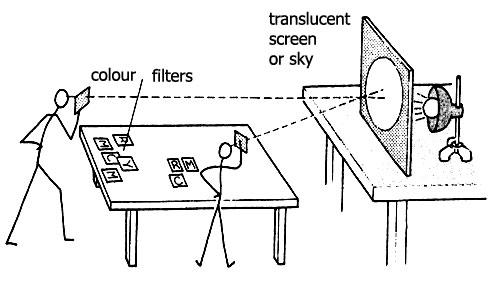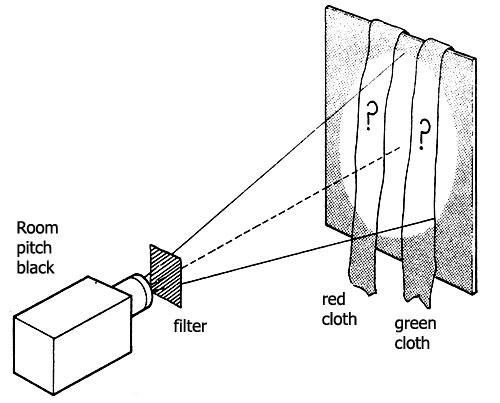How Does A Secondary Colour Filter Work
The Electromagnetic Spectrum
Light, Sound and Waves
Understanding colours
Applied Activity for xiv-xvi 

Demonstration
Using filters to produce coloured lights and find coloured objects.
Appliance and Materials
For each educatee or group of students
- Pieces of each of the following Lee plastic colour filters:
- Primary red (No- 106)
- Chief light-green (No- 139)
- Primary blueish (No- 79)
- Magenta (purple) (No- 113)
- Xanthous (No- 101)
- Samples of brightly coloured fabric And...
- Light source, compact
- Power supply for light source, depression voltage, variable
- Lens, +6D
- sixty-degree prism, large (preferably high dispersion)
- White screen or bare wall
- Translucent screen
- Depression ability lamp to go backside screen
- Small projector to provide large patch of coloured low-cal
- Gear up of colour filters (60 mm x sixty mm) for projector
- Bunsen burner with salt
Health & Prophylactic and Technical Notes
If the demonstration spectrum uses the compact light source, check that the form cannot observe the white light directly.
Read our standard health & condom guidance
The Lee
filter numbering arrangement is that used most widely in the stage lighting and photographic business. Sheets of plastic filter about 1 m x 0.5 1000 can be obtained from photographic and lighting suppliers for less than UKP 5 per sheet (September 2006). 1 such supplier is: Back Stage Shop.
Pieces of filter most 100 mm 10 100 mm are suitable equally it is easier for students to wait with both eyes: it also lessens confusion in handling if large pieces are used.
Beforehand, use a felt-tipped pen to label each filter R, K, B, C, M or Y.
It will save time and trouble if each prepare of six different filters is put in an envelope set to be issued. A primal list can be printed on the envelopes: e.thou.
R is Ruby
M is MAGENTA (RED + Blue) etc.

Process
Examining colour filters
- Ready up a...
Sit-in spectrum
...Arrange it then that the screen faces the class normally, only that the spectrum falls on the screen very obliquely so that a long spectrum is seen. Position the translucent screen far away from the spectrum screen and place a depression wattage lamp behind information technology as a groundwork to view thecolour
of a filter. For parts three, iv and 5, the rest of the room should be equally dark as possible. - With the lab well-lit, examine the filters, looking through each in turn at the lighted translucent screen or the bright sky. Use 1 filter at a time first, only allow students to experiment with combinations if they wish. Observe a piece of ruby cloth through a ruddy filter and then a green filter. Echo this using a greenish filter.
- Principal filters and spectra: Darken the room as much as possible but proceed a pocket-sized lamp running behind the translucent screen and so that students tin select the filter they want. Look at the spectrum through a ruby-red filter, then green, and then blue.
- Secondary filters and spectra: Echo 3 using cyan, magenta so a yellow filter.
- With a pocket-size projector throw a large patch of cherry-red light on the wall by hanging a ruby-red filter on the forepart of the projection lens. Show pieces of coloured textile in that red calorie-free: with no other light in the room. Change to light-green light (the green filter will transmit a fiddling cherry-red also as all green).
- Return to full daylight. Look at the bright screen or heaven through pairs of filters
in series
. - RED and Light-green
- MAGENTA AND CYAN
- CYAN and Common YELLOW
- MAGENTA and COMMON Yellowish
- Take three big pieces of filter, magenta, cyan and yellow, and tape them on a window pane, overlapping, so that they can act as a reminder to the course.



Education Notes
- Some main schools study colour so some students may recollect some of this.
- In function 2 y'all might ask students how the filters make calorie-free coloured. Does the red dye change all parts of the spectrum to red, or does information technology only cut out other colours and leave the ruddy that was ever there in the white light? Is the dye a color adder or a color subtractor? Filters transmit their own colour and absorb the balance. They practice not dye all the light with their own color. They subtract color.
- The dye in a piece of coloured cloth is a selective filter. A piece of red material tin can only return red calorie-free to our eyes and look red if it receives some reddish light. If reddish cloth is observed in white light or magenta lite, its reddish colour tin be seen considering each of those contains red calorie-free. Just if it is observed in just light-green lite, the cloth looks black because it receives no crimson calorie-free to return.
- The red filter is plain red.
- The light-green filter is apparently light-green and is the colour our eyes are most sensitive to.
- The bluish filter is plainly blue.
- The cyan filter is made from blue and dark-green.
- The magenta filter is fabricated from red and blue.
- The xanthous filter is made from red and green and not the pure yellow of a sodium lamp.
- In function 3 ask students what each filter does to the various coloured lights. Does a red filter blot out (absorb) parts of the spectrum or does it paint the spectrum cherry? Does it industry more than red light or only leave red low-cal that was already there? (It filters and then it subtracts.)
- Using the secondary filters in part 4 to view a white light spectrum, first of all singly, and so through two or more filters, volition show that secondary filters transmit two colours. Two overlapping filters will transmit just the colour common to both of them. The yellow filter will transmit ruby-red and green, as well as a little true xanthous. Almost all the yellows are mainly red + light-green, a
subjective yellow
. True yellowish is such a narrow band that adding it to the mixture of reddish and green makes lilliputian difference. - RED lets through only RED, GREEN lets through just Greenish. And so nothing gets through both, giving Blackness.
- CYAN + MAGENTA - only Truthful BLUE gets through
- CYAN + Xanthous - only Light-green gets through
- MAGENTA + Yellow - simply Cerise gets through
- MAGENTA + Xanthous + CYAN - transmits nothing (Black)
- So Magenta, Cyan and Yellow are best for colour printing, Technicolour films, and water-colour paints. These operate by subtractive colour mixing.
- All colour films have three colour layers made up of each of the secondary colours. You tin show this past building up a layered pic on an OHP. Look at the negative and print produced by color film and notation the colours.
- Pure yellow comes from a narrow part of the spectrum such as the light produced in a sodium flame. A cherry car near a sodium street lamp will look black.
- The dyes in filters are used in water-colour paints, and fifty-fifty when the paints are mixed each paint does its own filtering job. When mixing blue and yellow in a paint box to make light-green, you are really using cyan and yellow, and the common colour transmitted is greenish.
This experiment was safety-tested in Jan 2007
How Does A Secondary Colour Filter Work,
Source: https://spark.iop.org/understanding-colours
Posted by: montanomingat79.blogspot.com


0 Response to "How Does A Secondary Colour Filter Work"
Post a Comment